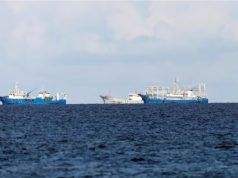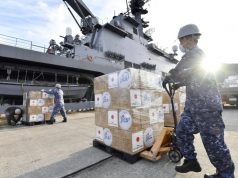
WASHINGTON/MANILA— The Philippines this week granted the United States greater access to its military bases, amid mounting concern over China’s intentions toward self-ruled Taiwan and Beijing’s extensive claims in the disputed South China Sea.
RELATED: Philippines grants U.S. greater access to bases amid China concerns
Here are answers to some questions about the U.S.-Philippines relationship:
What have the United States and the Philippines agreed?
The Philippines will give the United States access to four more locations under the 2014 Enhanced Defense Cooperation Agreement (EDCA), which allows for joint training, pre-positioning of equipment and the building of facilities such as runways, fuel storage and military housing, but not a permanent presence.
In announcing the deal, which brings the total number of EDCA sites to nine, the two sides did not specify where the new facilities will be located, noting they were still consulting local governments.
Manila’s former military chief said last year Washington had asked for access to bases on the main northern island of Luzon, the closest part of the Philippines to Taiwan, and on Palawan, near the disputed Spratly Islands in the South China Sea.
Southeast Asia Expert Gregory Poling at Washington’s Center for Strategic and International Studies said the sites would be in “strategic areas” and likely include navy and perhaps Marine Corps facilities.
“The choice of new sites in Luzon will be the most telling,” he said, listing the new Philippine Navy facility at the former Hanjin Shipyard in Subic Bay and a facility in northern Luzon, such as at the coastal Cagayan Province, as other possibilities.
Why is the Philippines so important to the United States?
The Philippines is a former U.S. colony and became a U.S. treaty ally in 1951, five years after independence. During the Cold War, it hosted some of America’s largest overseas bases, facilities vital to the wars in Korea and Vietnam. Philippine nationalism forced Washington to vacate those in the 1990s, but the allies have since cooperated on counter-terrorism and in response to rising Chinese military pressure in the South China Sea, where the Philippines has rival claims.
Of the five U.S. treaty allies in the Indo-Pacific – Australia, South Korea, Japan, the Philippines and Thailand – the Philippines is closest to Taiwan, its northernmost land mass of Luzon just 200 km (120 miles) away.
Experts say Luzon is of great interest to the U.S. military as a potential location for rockets, missiles and artillery systems that could be used to counter an amphibious invasion of Taiwan.
A senior U.S. official called EDCA a Biden administration priority and “part of our strategic effort across the region.”
The political environment for greater military access improved under Philippine President Ferdinand Marcos after a rocky period of relations under his predecessor Rodrigo Duterte, who sought closer ties with China.
China has said greater U.S. access to Philippine military bases undermines regional stability and raises tensions.
“This is an act that escalates tensions in the region and endangers regional peace and stability,” China’s foreign ministry spokesperson Mao Ning told a regular briefing on Thursday.
How would a Taiwan conflict affect the Philippines?
Poling says it would be difficult for Manila to remain neutral in a Taiwan conflict given its proximity and its treaty obligations to Washington. It would be the most likely destination for Taiwanese refugees and some 150,000 Filipinos living on the island would be endangered by any Chinese attack.
Jose Manuel Romualdez, Manila’s ambassador to Washington and a relative of Marcos, said last year Manila would let U.S. forces use its bases in the event of a Taiwan conflict only “if it is important for us, for our own security.”
Speaking to Reuters this week, Romualdez highlighted the Filipino workers on Taiwan and said Manila would respect its defense treaty with the United States.
What does Manila expect in return?
Poling said providing Manila funding to modernize its long-neglected armed forces was key. Washington recently announced $100 million in foreign military financing and $82 million for EDCA sites, but amounts are small compared to what Washington sends to the Middle East and Ukraine.
“The second Philippine demand is a continued clear commitment to defend Filipinos in the South China Sea,” Poling said. “They have that rhetorically, but the question for both sides is, do they have it functionally? If there was a Chinese attack on a Philippine base in the South China Sea tomorrow, could the Americans actually do anything about it? And that is far less clear, which is another reason EDCA is so important.”
—Reporting by David Brunnstrom and Karen Lema; Editing by Don Durfee and Josie Kao









